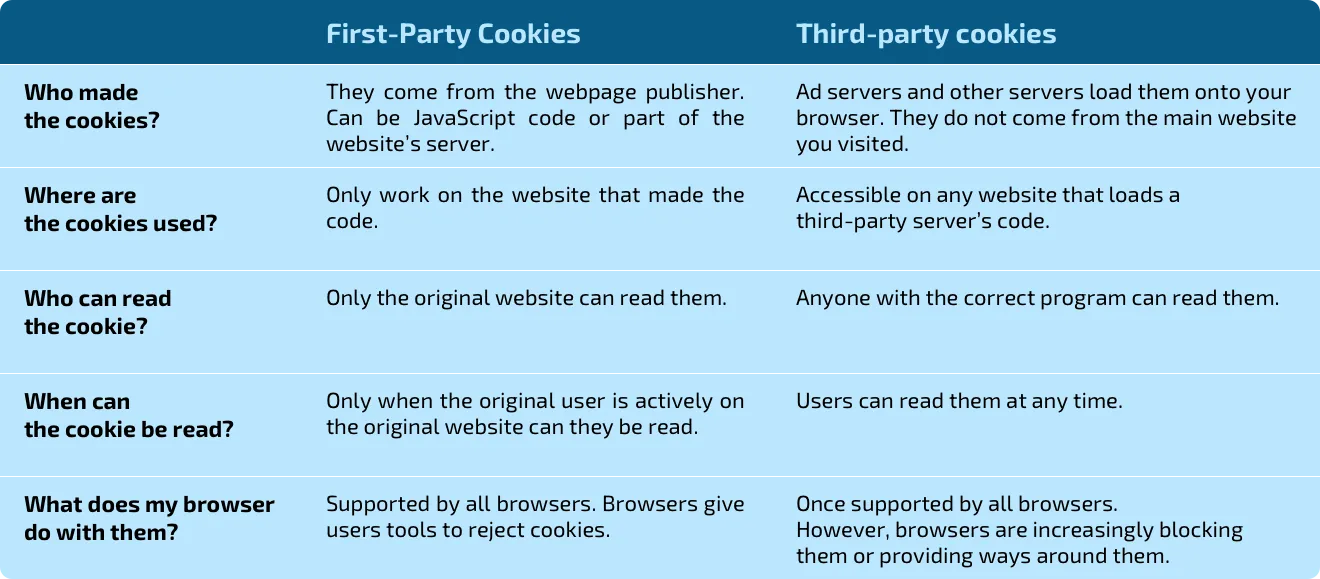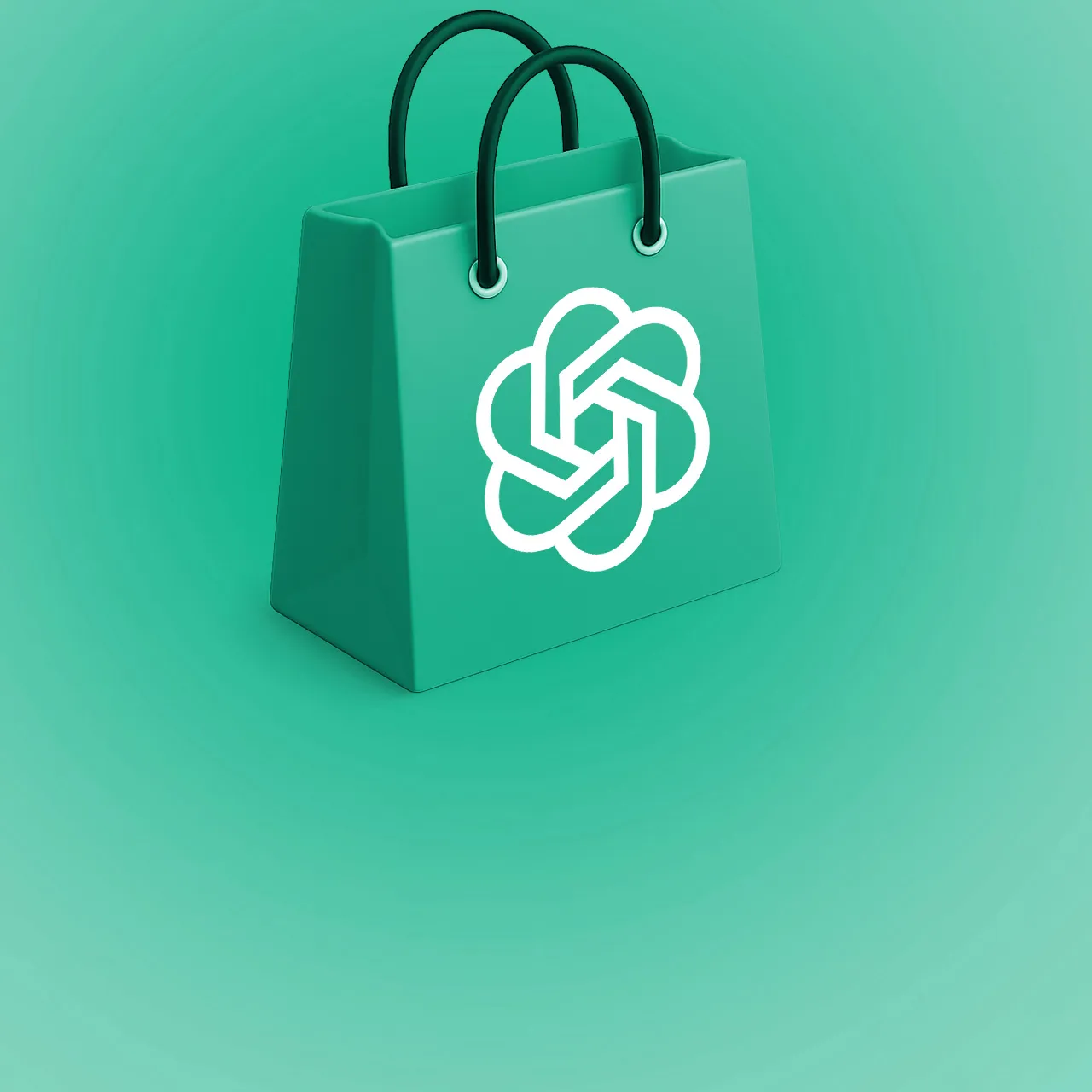read
Google announced its termination of support for third-party cookies and later clarified this change will happen in 2023. Almost immediately, ad tech companies wanted to know how ad targeting would work. Everyone began to worry about how this would affect their campaign effectiveness. Advertisers are coming to see how a cookieless future may, in fact, be a better one.
In this article, we’re going to give you a broad overview of three things:
What cookies are and why this change is important.
How online advertising companies can continue to gather data and target ads with Google’s Analytics 4.
How to use other tools to market to internet users on specific platforms.
What are Cookies?
Cookies are small pieces of text or code that record a user’s activity on a website. They are stored in web browsers and read by websites when a user visits. The Google Chrome browser has 65% market share and uses cookies, so Google’s change is significant.
Broadly speaking, there are two major types of cookies in use right now.
First-Party Cookies
First-party data and cookies are bits of code that have a home. They remain on the website that created them. Companies collect first-party data for functional tasks, such as tracking user preferences, activity history, and login information.
First-party cookies are used to create a personalised experience on a specific website. These cookies do not follow a user across the internet.
Third-Party Cookies
Third-party cookies track users across the internet from one website to another. Consumer privacy concerns, “over targeting,” and changes in privacy laws are coming together to drive the shift away from third-party cookies.
Without a doubt, third-party cookies develop a more complete picture of the user. Advertisers create them because they allow specific targeting of potential customers based on data from other websites. This reduces the amount of market research needed, because website owners can simply tell each other about specific customers.

Why have cookies been so important?
Cookies, especially third-party cookies, have been incredibly influential because they allow brands to target customers without first building direct relationships with them. Since brands can accurately target unknown customers, their cost savings for basic brand building are huge.
Why are third-party cookies going away?
During the last decade, rises in privacy fears, fueled by more security breaches and malicious actors, have caused companies to look for better outcomes for consumers while abandoning third-party cookies.

Clearly Define Your Market and Competitors
What does the end of third-party cookies mean for digital advertising?
Here’s the good news:
A cookieless future will not put advertisers out of work.
Instead, ditching cookies means advertisers will be more valuable than ever. The most successful companies will become adept at cookieless analytics, contextual targeting, and using data to develop a better understanding of users, leading to better outcomes for website owners and visitors.
Before we talk about how to succeed without third-party cookies, let’s have a quick look at how this will affect the key groups.
For Google
Google Chrome used third-party cookies extensively, so this is a big change for Google. To continue to offer targeted advertising, Google responded with a few initiatives:
The privacy sandbox, which attempts to bring developers and others together to create the next way of connecting users, data, and advertisers in a less invasive way.
Google tried a program called FLoC, but has discarded this for their Topics API. This will create a set of topics in the user’s browser based on their browsing history. These topics are then shared with sites you visit. This keeps the user anonymous while still giving advertisers information about which topics will be of interest to site visitors.
Google has also recommended strengthening relationships with customers to build more first-party data for better targeting.
For the advertising industry
Advertising agencies and individuals have some time to prepare for a cookieless internet. However, the most common analytics tool, Google Analytics, may not provide the same type of user data they have seen before. While the lack of specific data may require adjustments, advertisers will leverage cohort data and the best alternatives to produce results.
For user privacy
Users keen to protect their personal data will not be saddened by the departure of the third-party cookie. However, defining what one is and does requires a bit of careful thought.
For example, which of these is an acceptable use of third-party data?
Live chat popups
Social sharing buttons
Ad retargeting services
In the end, users may not want to throw the personalised website experience baby out with the panicky total privacy bath.
The result will probably be a model where marketers give users more control over their data, while still using at least some personal data for advertising.
How can digital marketing companies succeed in a cookieless world?
Marketers can turn to a few forms of cookieless tracking and contextual targeting to show relevant ads to users on a website. The data may not be as granular, but valid insights can still be produced.
The two most likely answers are GA4 and server-side tagging using Google Tag Manager or something like it.
Use Google Analytics 4 (GA4) to collect data
It is possible to use GA4 to perform some cookieless tracking. The amount of data collected about specific users will be much lower, but marketers will still be able to see a few key metrics.
What types of data will replace cookies?
GA4 is based on tracking events, where Universal Analytics tracked sessions. GA4 relies on machine learning to predict user behaviour and allow for specific targeting. Specific possibilities for GA4 include:
Creating audiences based on churn probability increase engagement.
Modelling conversions with machine learning to supply data where it is not available for a subset of conversions.
Tracking cross-device and cross-platform user behaviour with machine learning. Note that this could lead to modeling behaviour instead of merely recording it.
Highlighting relevant changes automatically, such as a sharp increase or decrease in demand for a specific product or category.
GA4, data protection, and privacy concerns
GA4 makes cookieless tracking possible and should reduce privacy violation fears. Since users will be anonymised, their data should be more secure. Each website will also collect less data about individuals, making data breaches potentially less damaging.
What types of data will replace cookies?
Individual data shared by third-party cookies will be replaced by a few alternatives:
Group or cohort data that cannot be personalised
Event data, such as page views or video watch time
Website specific first-party data
Ad tech companies are also working to create consent-based systems that will replace or mimic cookies. These will give users control and allow them to opt out, but also keep the functions of cookies for advertisers who use them.
Why do you need to make the switch? Read our article about the top benefits of Google Analytics 4 (GA4) to understand the whole story.
Server-side Tagging (GTM)
Marketers can block GA4 from storing the clientID in a cookie. This can be done using an automatic script and tag manager. The result should be a new, random clientID on each page upload. Since the clientID will be randomised on each page, this method will render the individual user anonymous.
However, it also reduces data to specific events, and disconnects them from one another. For example, the user comes to the home page via an ad. The data about the user’s visit, especially their referring page, will still be visible. What will be invisible is the next activity, such as viewed pages.
Claim Your Free Audit to Uncover Hidden Opportunities
Cookieless Solutions for digital marketing
Marketers have multiple options for advertising without cookies already. Google is no longer the only game in town and rivals such as Amazon and Facebook are arguably more important for some businesses.
Let’s have a quick look at how companies can do cookieless advertising via a few methods, including Google Ads.

Clearly Define Your Market and Competitors
Cookieless advertising on Facebook
Facebook (aka Meta) will be moving users to its Conversions API. This has been developed to allow users to share data from their server. This bypasses the browser, so there should not be any data loss from no longer using cookies.
Here’s how it works:
Conversions API data is fed directly into Facebook and handled similarly to pixel events, allowing advertisers to monitor conversions and make adjustments in Ads Manager.
Instead of sharing data via a browser, marketers will use the Conversions API to exchange data directly from their server.
The Conversions API is also built to respect Facebook users’ privacy preferences
Cookieless marketing in Google Ads
Google Ads allows targeting via the Search and Display networks (including YouTube). The future will look different for these marketing channels.
The Search Network will not be as affected because it is very keyword-driven. Cookies are not the primary way advertisers target a user in the search results.
The Display Network is different. Advertisers use cookie data to target consumers on thousands of connected websites and video channels. These ads will change and will need to rely on more contextual targeting, first-party data, and machine learning to predict the best targeting options.
Cookieless ads for ecommerce
Cookieless marketing will be possible and may even be better. Consumers value their privacy, so adjusting to their expectations can create the trust that builds loyalty.
There are at least three things companies can do to prepare their ecommerce business for effective advertising after the cookies are all gone:
Build better first-party datasets and use them effectively.
Rebuild contextual campaigns, including organic search and website networks.
Explore data clean rooms, such as Google and Facebook.
Ecommerce companies will still have effective advertising options, but the challenge will likely fall to digital marketing companies to show a clear connection between money spent and conversions earned.
Advertising after the Cookiepocalypse: Not So Bad After All
The cookie deprecation may feel like an advertising apocalypse, but it’s not so bad. Consumers are already turning away from brands that do not respect their privacy. Thus, advertisers, brands, and websites that proactively build better advertising may see more loyalty to their site. The options for advertising without cookies are also growing, so brands will be able to reach out to customers.


![AI Advertising in 2025: Real ROI vs Expensive Hype [Guide]](/_ipx/f_webp/img/blog/blog-ai-in-the-advertising-space.jpg)
